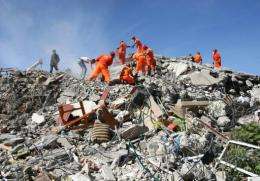Rescuers take part in an operation to salvage people from a collapsed building after an earthquake in eastern Turkey. The 7.2-magnitude earthquake that struck Van province in eastern Turkey on Sunday, causing hundreds of fatalities, underscores the country's fate to be straddling one of the world's most active seismic zones.
The 7.2-magnitude earthquake that struck Van province in eastern Turkey on Sunday, causing hundreds of fatalities, underscores the country's fate to be straddling one of the world's most active seismic zones.
Turkey is squeezed between two tectonic plates -- Eurasia to the north and Africa/Arabia to the south -- that are grinding into each other, according France's Paris Institute of the Physics of the Globe (IPGP).
Sunday's quake occurred on the East Anatolian Fault where an arrow-shaped plate, comprising the Arabian peninsula, part of southeastern Turkey and Iraq, is forcing its way under the Eurasian plate at an average speed of 2.4 centimetres (one inch) per year.
This same fault was to blame for the Spitak quake in Armenia in 1988, when more than 20,000 people were killed by a 6.9-magnitude event.
In 1976, several villages on the Turkish-Iranian border were wiped out by a 7.3-magnitude quake that occurred around 70 kilometres (44 miles) from Sunday's quake.
Turkey's other big seismic front is the North Anatolian Fault, where several quakes occurred last century along almost its entire length.
A 7.8-magnitude quake at Erzincan in 1939 claimed nearly 33,000 lives, and the 1999 Izmit quake, estimated at 7.6 to 7.7 magnitude, left a toll of 17,000 dead and 50,000 injured, while around half a million people were left homeless.
(c) 2011 AFP






















